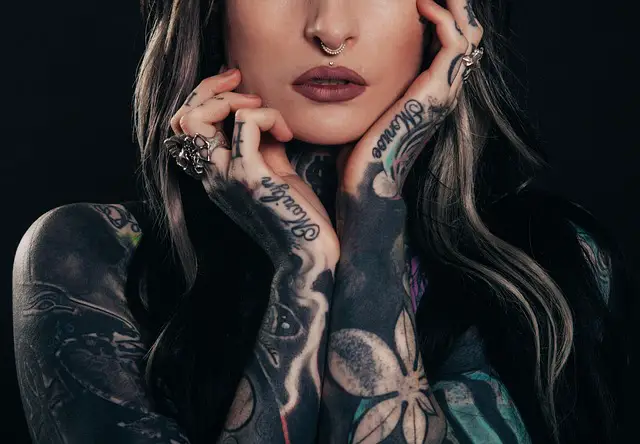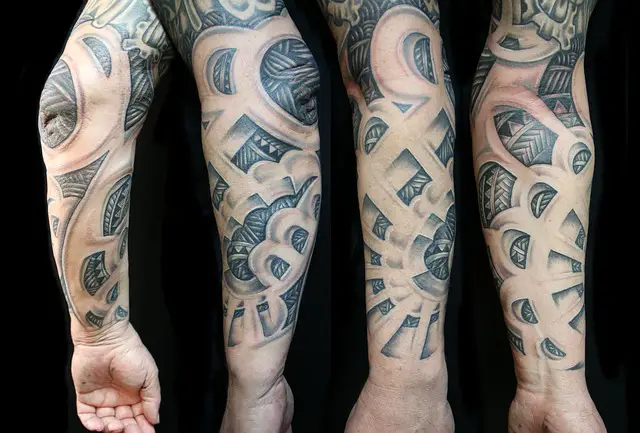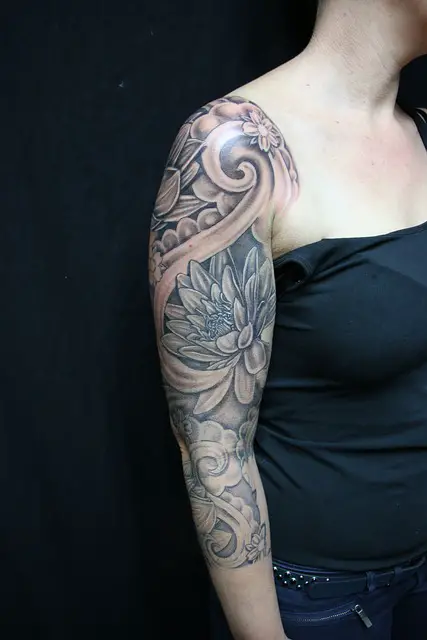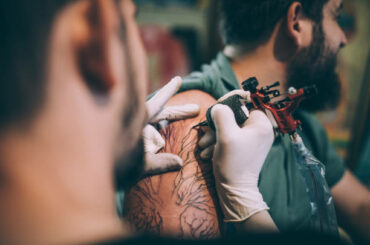Contents
Introduction: The Evolution of Tattoo Artistry
Tattoos, a Timeless Form of Self-Expression:
Tattooing, with roots dating back centuries, has long served as a powerful medium for individuals to express their identity, beliefs, and experiences. From ancient tribal markings to cultural symbols, tattoos have played a crucial role in personal and communal storytelling.
The Shifting Landscape of Tattoo Artistry:
In recent times, the artistry of tattoos has experienced a notable evolution. A departure from conventional norms, contemporary tattoo culture has become a canvas for boundless creativity. Artists and enthusiasts alike are breaking free from traditional constraints, fostering an environment that thrives on diversity and embraces the unique narratives each individual brings to the table.
Embracing Diversity and Creative Freedom:
A significant trend in this modern era of tattooing is the celebration of diversity and the unbridled freedom of expression. No longer confined to a specific set of styles or motifs, tattoo artists and their clients are exploring a rich tapestry of artistic choices. This shift reflects a broader societal acceptance of diverse aesthetics and a rejection of the notion that tattoos must adhere to a singular, predefined style.
Posing the Question: “Can You Have Two Different Styles of Tattoo Sleeves?”:
As the boundaries of tattoo artistry continue to expand, a compelling question arises: Can one seamlessly blend two different styles within the canvas of a tattoo sleeve? This query sets the stage for an exploration of the possibilities, challenges, and creative expressions that arise when individuals choose to combine diverse tattoo styles in a cohesive and visually striking manner. Join us on this journey as we delve into the evolving landscape of tattoo sleeves, where the answer to this question unfolds through the artful intersection of tradition and innovation.

Understanding Tattoo Sleeves and Styles
Defining Tattoo Sleeves:
Tattoo sleeves represent an intricate and comprehensive form of body art, where a significant portion, or the entirety, of an individual’s arm, is adorned with a cohesive design. Unlike individual tattoos, sleeves create a harmonious and integrated visual narrative that unfolds across the skin canvas.
Significance in the Realm of Body Art:
The significance of tattoo sleeves extends beyond aesthetic appeal; they serve as a testament to personal stories, passions, and the journey of self-discovery. As a comprehensive tapestry, tattoo sleeves allow individuals to curate a visual representation of their identity, encapsulating a myriad of meanings within the inked strokes and designs.
Exploring Diverse Tattoo Styles:
The world of tattooing encompasses a rich tapestry of styles, each with its own visual language and artistic nuances. From the timeless and bold lines of traditional tattoos to the intricate details of realism, the geometric precision of shapes, and the vibrant hues of watercolor, the spectrum of possibilities is vast and diverse.
Traditional Style:
Characterized by bold outlines, rich colors, and classic motifs, traditional tattooing pays homage to the roots of this art form. Icons like anchors, roses, and nautical symbols are staples in this style, creating a timeless and iconic aesthetic.
Realism:
Realism in tattoo art strives to replicate the intricacies of the real world. Artists adept in this style master the art of capturing lifelike details, bringing portraits, landscapes, and even everyday objects to life on the skin.
Geometric Precision:
Geometric tattoos are marked by their use of precise lines, shapes, and patterns. From sacred geometry to minimalist designs, this style celebrates symmetry and mathematical beauty, creating visually stunning and often symmetrical compositions.
Watercolor Expressiveness:
Blending hues seamlessly and often lacking defined outlines, this style achieves a painterly effect on the skin, resulting in a unique and expressive aesthetic.
The Evolution:
One of the most intriguing aspects of contemporary tattooing is its fluidity and adaptability. As the art form continues to evolve, there’s a growing recognition that individual expression knows no bounds.
The once rigid boundaries between tattoo styles are dissolving, giving rise to a new era where artists and enthusiasts alike have the freedom to combine and integrate different styles within a single composition.
Embracing Diversity in Tattoo Sleeves:
The evolution of tattooing has paved the way for an exciting era of creative exploration. Tattoo sleeves, once confined to a singular style, now serve as a dynamic canvas for the convergence of traditional, contemporary, and avant-garde styles. This newfound freedom allows individuals to weave a rich tapestry of diverse visual elements into a seamless and personalized narrative on their arms.
As we delve deeper into the realm of tattoo sleeves, the interplay of different styles emerges as a testament to the boundless possibilities within modern tattoo artistry. The journey to answer the question of whether two different styles can coexist within a sleeve unfolds against this backdrop of artistic diversity and creative expression.
Breaking Stereotypes: Embracing Eclectic Choices
The Shift Away from Traditional Norms:
In the ever-evolving landscape of tattoo artistry, a noticeable shift is taking place—a departure from the conventional norms that once dictated the acceptable boundaries of body art. Traditional expectations, often rooted in specific styles or motifs, are giving way to a new era where individuality and creativity flourish.
Embracing Freedom of Expression:
Individuals are increasingly breaking free from the stereotypes that previously constrained the realm of tattooing. This liberation is marked by a collective desire to embrace diverse and unconventional choices in body art. The tattoo industry is witnessing a surge in clients seeking tattoos that defy traditional expectations and reflect their unique personalities.
Diverse and Eclectic Choices:
This departure from norms is best exemplified by the embrace of eclectic choices in body art. No longer confined to a singular style or theme, individuals are choosing tattoos that resonate with their narratives, passions, and interests. This eclectic approach allows for a fusion of styles, creating visually captivating and deeply meaningful compositions that challenge the status quo.
The Growing Acceptance of Diverse Styles:
Perhaps one of the most significant developments is the growing acceptance of diverse tattoo styles within a single composition. In the past, there may have been reservations about combining different aesthetics, but contemporary tattoo culture celebrates the beauty of eclecticism. Artists and enthusiasts alike are pushing boundaries, demonstrating that diverse styles can not only coexist but also harmonize to create breathtaking and cohesive body art.
From Conformity to Creative Freedom:
The tattoo industry’s evolution reflects a broader societal shift from conformity to creative freedom. Clients are no longer bound by predetermined expectations; instead, they are actively seeking ways to express their authenticity through body art. This departure from traditional norms signals a paradigm shift in how tattoos are perceived—a transition from conformity to a celebration of individuality.
Championing Self-Expression:
Breaking stereotypes in tattooing is, at its core, a celebration of self-expression. It is a powerful declaration that one’s body is a canvas for personal storytelling, free from the constraints of societal expectations. This movement champions the belief that tattoos should be as diverse and unique as the individuals who wear them, paving the way for a more inclusive and accepting tattoo culture.
Inspiration from Varied Sources:
Eclectic choices in body art draw inspiration from a myriad of sources—personal experiences, cultural influences, artistic preferences, and beyond. This openness to diverse influences has given rise to tattoos that transcend traditional boundaries, reflecting the richness and complexity of individual stories.
As we explore the breaking of stereotypes in tattooing, the emergence of eclectic choices serves as a testament to the evolving nature of body art. The journey to answer whether two different styles can harmonize within a tattoo sleeve is intricately woven into this narrative of breaking free from expectations, embracing diversity, and championing the beauty of creative expression on the human canvas.

The Art of Fusion: Can Styles Coexist?
Exploring the Possibilities:
Delving into the realm of tattoo sleeves, a captivating question emerges: Can two different styles seamlessly coexist within a single composition? This inquiry unveils the art of fusion, where the boundaries between distinct styles blur, giving rise to a harmonious and visually stunning tapestry of ink.
Breaking Down Style Barriers:
Traditionally, the notion of combining different tattoo styles might have raised eyebrows, as each style came with its own set of rules and aesthetics. However, contemporary tattoo culture has dismantled these barriers, paving the way for a new era where artists and enthusiasts eagerly explore the uncharted territory of style fusion.
Successful Combinations:
The beauty of the art of fusion lies in its ability to bring together seemingly disparate styles in a way that not only works but elevates the overall visual impact of the tattoo sleeve. Successful combinations are a testament to the skill and creativity of both the tattoo artist and the individual seeking a unique and personalized work of art.
Illustrative Examples:
Traditional and Realism Fusion:
The bold lines and vibrant colors of traditional tattoos can seamlessly blend with the intricate details and lifelike representations of realism. Imagine a sleeve where a traditional anchor transforms into a realistic seascape, creating a dynamic and visually engaging narrative.
Geometric and Watercolor Harmony:
The precision of geometric shapes can be gracefully integrated with the free-flowing, watercolor strokes. This combination results in a mesmerizing fusion where structured patterns dance with vibrant hues, creating a balance between order and fluidity.
Cultural Fusion:
Combining styles from different cultural influences can yield breathtaking results. Picture a sleeve where elements of Japanese irezumi seamlessly intertwine with intricate Maori patterns, forming a unique synthesis of diverse artistic traditions.
Abstract and Script Elegance:
The abstraction of shapes and forms can coalesce with the elegance of script, producing a sleeve where abstract designs frame meaningful words or phrases. This juxtaposition adds layers of depth and personal significance to the overall composition.
The Synergy of Style Fusion:
The success of these combinations lies in the synergy created when different styles interact harmoniously. It’s not merely about placing contrasting elements side by side; rather, it’s a delicate dance where each style enhances the other, resulting in a cohesive and visually captivating whole.
The Role of Skill and Vision:
Achieving a harmonious fusion of styles requires not only technical skill but also a visionary approach from both the tattoo artist and the individual receiving the tattoo. Collaborative discussions, shared inspiration, and a mutual understanding of the desired outcome play pivotal roles in bringing the art of fusion to life.
Championing Individuality:
The art of fusion is a celebration of individuality, where personal stories, preferences, and aesthetic choices converge into a singular masterpiece. In the exploration of whether two different styles can coexist within a tattoo sleeve, the resounding answer is found in the dynamic and ever-evolving landscape of contemporary tattoo artistry.

Overview of Popular Tattoo Styles:
Tattooing, as an art form, has evolved into a diverse landscape of styles, each with its distinct characteristics and visual language. Understanding these styles is crucial for individuals seeking to navigate the intricate world of tattoo sleeves and explore the fusion of different artistic elements.
Traditional Tattoos:
Characteristics: Bold lines, vibrant colors, and classic motifs such as anchors, roses, and nautical symbols.
Visual Language: Timeless and iconic, traditional tattoos draw inspiration from historical designs, showcasing a rich heritage.
Realism:
Characteristics: Detailed and lifelike representations that aim to replicate the real world.
Visual Language: Achieves a photographic quality, capturing the nuances of portraits, landscapes, and everyday objects with precision.
Geometric Tattoos:
Characteristics: Precise lines, shapes, and patterns, often rooted in mathematical concepts.
Visual Language: Celebrates symmetry and order, creating visually stunning compositions through geometric precision.
Watercolor Tattoos:
Characteristics: Emulates the fluidity and vibrancy of watercolor paintings, often lacking defined outlines.
Visual Language: Painterly and expressive, watercolor tattoos bring a unique and dynamic aesthetic to the skin.
Insights into Artistic Elements:
Each tattoo style is a distinct form of artistic expression, and delving into their specific elements provides insight into the craftsmanship and intention behind the ink.
Traditional Style:
Bold outlines and a limited color palette contribute to the iconic look.
Classic motifs carry cultural significance and timeless appeal.
Realism:
Attention to detail and shading techniques create a three-dimensional effect.
Mastery of color realism involves replicating natural hues with precision.
Geometric Precision:
Focus on mathematical precision, symmetry, and clean lines.
Designs often involve intricate patterns and shapes.
Watercolor Expressiveness:
The blending of colors without defined outlines.
Emphasis on fluidity and capturing the spontaneity of watercolor paintings.
Understanding Each Style for Combination:
Navigating different tattoo styles requires a nuanced understanding of their characteristics. When considering a combination, this understanding becomes the foundation for creating a harmonious and visually compelling tattoo sleeve.
Harmonizing Aesthetics:
Recognizing the aesthetic principles of each style helps in harmonizing visual elements within the composition.
Balancing Contrasts:
Understanding the contrasts between styles, such as the boldness of traditional tattoos versus the subtlety of watercolor, allows for intentional and balanced combinations.
Storytelling Potential:
Each style brings its storytelling potential. Traditional motifs may convey cultural narratives, while realism captures personal stories in intricate detail.
Collaborative Approach:
Collaborating with a skilled tattoo artist becomes essential. A mutual understanding of the desired outcome and a shared vision ensure a cohesive integration of diverse styles.
In navigating different tattoo styles, individuals embark on a journey of self-discovery and creative expression. The appreciation of each style’s unique elements lays the groundwork for exploring the vast potential of combining them within a single, artful tattoo sleeve.
Collaborating with Tattoo Artists
Significance of Open Communication:
Collaborating with a tattoo artist is a dynamic and essential aspect of the tattooing process. Open communication forms the cornerstone of a successful partnership between the individual seeking a tattoo and the skilled artist tasked with bringing their vision to life.
Crucial Role of Collaboration:
Artistic Expertise:
Tattoo artists bring a wealth of artistic expertise to the table. Their understanding of design principles, composition, and tattoo application is invaluable in translating ideas into visually striking realities.
Collaboration is especially crucial when navigating the fusion of different tattoo styles. Artists possess a deep knowledge of each style’s nuances and can provide insights into how various elements can harmonize within a single composition.
Translating Ideas into Art:
Effective collaboration ensures that the artist comprehends the individual’s vision. Clear communication about style preferences, thematic elements, and desired symbolism aids the artist in translating these ideas into a cohesive and meaningful tattoo.
Crucial Elements of Collaborative Success:
Establishing a shared vision is fundamental. Both the individual and the artist should align on the desired outcome, ensuring that the final tattoo reflects the individual’s narrative while showcasing the artist’s creative flair.
Feedback and Adjustments:
The collaborative process involves ongoing communication. Constructive feedback and a willingness to make adjustments contribute to refining the design until it perfectly encapsulates the envisioned fusion of styles.
Mutual Respect:
Mutual respect between the individual and the artist fosters a positive collaboration. Recognizing each other’s expertise and contributions ensures a harmonious working relationship.
Seeking Professional Guidance:
Expert Insight:
Tattoo artists are not only skilled practitioners but also design experts. Seeking their professional guidance provides valuable insights into the technical feasibility of combining styles and the potential visual impact of the chosen elements.
Portfolio Review:
Reviewing the artist’s portfolio is a crucial step. It allows individuals to gauge the artist’s proficiency in handling diverse styles and ensures that their artistic approach aligns with the envisioned fusion.
Open Consultations:
Encouraging readers to schedule open consultations with potential tattoo artists facilitates direct communication. This allows individuals to discuss ideas, ask questions, and assess the artist’s enthusiasm for collaborative endeavors.
Artistic Preferences:
Readers are encouraged to openly share their artistic preferences, style inspirations, and thematic elements they wish to incorporate. This ensures that the collaboration is rooted in the individual’s unique vision.
Inspiration Boards:
Creating inspiration boards or mood boards can aid in conveying visual concepts. Sharing these with the artist provides a tangible reference point for discussions on style, color palette, and overall aesthetic.
Trusting the Process:
Encouraging readers to trust the artistic process is essential. Tattoo artists thrive when given creative freedom within the collaborative framework, leading to the co-creation of a truly remarkable and personalized tattoo sleeve.
In the journey of creating a tattoo sleeve that seamlessly fuses different styles, collaboration with a skilled tattoo artist emerges as a cornerstone. Through open communication, shared vision, and mutual respect, individuals can transform their artistic aspirations into enduring works of body art.

Achieving Visual Harmony
Strategies for Visual Harmony:
Understanding Individual Styles:
Begin by comprehending the unique characteristics of each tattoo style involved in the fusion. This understanding lays the foundation for informed decisions during the design process.
Balancing Elements:
Achieving visual harmony involves balancing contrasting elements. Whether it’s the bold lines of traditional tattoos against the subtlety of watercolor or the structured precision of geometric patterns with free-flowing realism, finding equilibrium is key.
Creating a Focal Point:
Establishing a focal point within the tattoo sleeve directs attention and creates cohesion. This central element can serve as the anchor that ties together diverse styles, providing a visual narrative for the entire composition.
Role of Balance, Composition, and Color:
Balancing Contrasts:
Effective balance ensures that no single style overwhelms the others. Contrasts, such as light and dark, intricate and simple, or vibrant and subdued, should be intentionally distributed throughout the sleeve.
Thoughtful Composition:
Thoughtful composition is central to visual harmony. Consider how different styles interact within the layout, ensuring a flow that guides the viewer’s eye across the entire sleeve without causing visual discord.
Harmonizing Color Palette:
Harmonizing the color palette is crucial. Even when combining vibrant watercolor with the subdued tones of realism or traditional tattoos, a coordinated color scheme contributes to a unified and visually pleasing aesthetic.
Tips for Maintaining a Unified Look:
Consistent Theme or Storyline:
Integrate a consistent theme or storyline that ties together diverse elements. Whether it’s a narrative thread, a shared symbolism, or a common visual motif, a unifying theme provides coherence.
Transitional Elements:
Use transitional elements strategically. Smooth transitions between different styles, such as incorporating geometric patterns as connecting bridges, contribute to the overall flow and unity of the tattoo sleeve.
Size and Placement Considerations:
Ensuring proportional representation of each style and thoughtful placement helps maintain a balanced and visually appealing composition.
Consult with the Artist:
Regular consultations with the tattoo artist are essential. Their expertise in design and placement, coupled with an understanding of each style, allows for real-time adjustments that enhance the overall visual harmony.
Embracing Diversity While Maintaining Unity:
Celebrating Diversity:
The beauty of a fusion tattoo sleeve lies in its diversity. Encourage individuals to embrace the unique qualities of each style, recognizing that the charm of the sleeve resides in its multifaceted and eclectic nature.
Personal Expression:
Remind readers that a tattoo sleeve is a form of personal expression. The fusion of styles should authentically reflect the individual’s personality, interests, and storytelling preferences.
Adaptability in Design:
Emphasize the adaptability of design. A dynamic and collaborative design process allows for adjustments that enhance the overall aesthetic appeal, ensuring that the final result is a cohesive masterpiece.
As individuals embark on the journey of combining different tattoo styles within a sleeve, achieving visual harmony becomes a shared goal. Through thoughtful balance, intentional composition, and a celebration of diversity, the collaborative efforts between the individual and the skilled tattoo artist culminate in a harmonious and visually captivating work of art.
Individuality and Personal Expression
Tattoos as Personal Expression:
A Canvas for Individuality:
Tattoos serve as a unique and intimate form of personal expression, transforming the body into a canvas where individual stories, passions, and experiences are artistically woven.
Beyond Aesthetics:
More than mere aesthetic adornments, tattoos are a visual language through which individuals communicate their identity, beliefs, and the depth of their narratives.
Two Styles, One Unique Expression:
Showcasing Personality:
Embracing two different styles within a single sleeve provides a powerful platform for showcasing individual personality. The fusion becomes a visual representation of the diverse facets that make each person uniquely themselves.
Reflecting Interests and Passions:
Having a blend of styles allows individuals to reflect their interests and passions dynamically. From traditional symbols that hold cultural significance to the hyper-realistic depictions of beloved memories, the fusion becomes a tapestry of personal significance.
Diverse Storytelling:
Each style contributes to a diverse storytelling experience. Whether it’s the bold narratives of traditional tattoos or the nuanced realism capturing specific moments, the combination offers a multidimensional reflection of the individual’s journey.
Consideration of Personal Preferences:
Exploring Personal Stories:
Encourage readers to explore their personal stories. What experiences, memories, or symbols hold profound meaning? Integrating these narratives into the tattoo sleeve adds layers of authenticity.
Symbolism and Meaning:
Delve into the symbolism and meaning behind chosen elements. From the anchor of stability in traditional tattoos to the lifelike portrayal of loved ones in realism, the symbolism embedded in the styles contributes to a personalized narrative.
Unveiling Authenticity:
The beauty of a tattoo sleeve lies in its authenticity. Readers are encouraged to unveil their true selves through art, choosing styles and elements that resonate with their genuine interests rather than conforming to external expectations.
Empowering Creative Expression:
Breaking Conventions:
Tattoos provide a platform for breaking conventions. Readers should feel empowered to move beyond traditional norms, embracing a blend of styles that truly captures their unique essence.
Creative Freedom:
Emphasize the creative freedom inherent in tattooing. Each style contributes to the overall masterpiece, and the combination becomes a testament to the limitless possibilities of creative expression.
In the world of tattoo sleeves, the combination of two different styles is a celebration of individuality and personal expression. It’s an opportunity for readers to embrace their unique stories, showcase their diverse interests, and create a visual narrative that authentically reflects who they are. As the ink becomes a part of their skin, it also becomes a part of their identity—a living canvas of personal expression.
Challenges and Considerations
Acknowledging Potential Challenges:
Style Cohesion:
Achieving cohesion between contrasting styles poses a challenge. The potential for visual dissonance may arise, requiring careful consideration during the design phase.
Transitional Flow:
Creating a seamless transition between styles, especially when they have distinct characteristics, can be challenging. Ensuring a fluid and natural flow across the sleeve is essential.
Balancing Detail:
Balancing intricate details within different styles without overwhelming the overall composition requires thoughtful consideration. Too much detail in one area may compete with elements in another.
Factors for Consideration:
Placement:
The placement of different styles plays a pivotal role in the overall success of the tattoo sleeve. Consider how each style complements the natural contours of the body and interacts with adjacent elements.
Size and Proportion:
Maintaining appropriate size and proportion for each style contributes to visual balance. A harmonious distribution ensures that no single style dominates the sleeve.
Color Harmony:
Harmonizing colors across styles is crucial. Disparate color palettes can create visual discord, so careful consideration of how hues interact is necessary.
Transition Zones:
Identifying and strategically placing transition zones between styles helps create a smooth visual flow. These zones serve as bridges, allowing for a gradual shift between contrasting elements.
Solutions and Considerations:
Collaborative Consultations:
Regular consultations with the tattoo artist facilitate open communication. Addressing challenges collaboratively ensures that both the individual and the artist are actively involved in finding solutions.
Mock-up and Adjustments:
Creating a mock-up of the design allows for visualizing the final composition. This step enables individuals and artists to make informed decisions and implement adjustments before the actual tattooing process.
Tested Techniques:
Tattoo artists often employ tested techniques to address challenges. Techniques like shading, background elements, or creative linework can contribute to a harmonious blend between styles.
Gradual Integration:
Gradual integration of styles over multiple sessions provides flexibility. This approach allows for a step-by-step construction of the tattoo sleeve, ensuring that each element is carefully integrated.
Size Gradation:
Consider a size gradation strategy, where elements of different styles vary in size based on their importance in the overall composition. This helps maintain balance and prevents overwhelming the sleeve with intricate details.
Combining two different tattoo styles within a sleeve is not without its challenges, but with thoughtful consideration, collaboration, and creative solutions, these challenges can be transformed into opportunities for artistic innovation. Acknowledging potential pitfalls and actively addressing them contributes to the successful creation of a visually harmonious and personally meaningful tattoo sleeve.
Conclusion: Celebrating Diversity in Body Art
Summarizing the Tapestry of Styles:
As we unravel the intricate journey of combining two different styles within a tattoo sleeve, a vibrant tapestry emerges—a tapestry woven with threads of individuality, creativity, and diverse artistic expressions.
Visual Symphony:
The fusion of two styles within a tattoo sleeve creates a visual symphony, where contrasting elements harmonize to tell a unique and deeply personal story.
Collaboration and Communication:
Collaboration with skilled tattoo artists, rooted in open communication, is fundamental. The success of a diverse sleeve lies in the synergy between the individual’s vision and the artist’s creative expertise.
Achieving Visual Harmony:
Visual harmony is not only achievable but essential. Through balance, thoughtful composition, and a celebration of color, different styles coalesce to form a cohesive and visually captivating masterpiece.
Embracing Individuality:
Tattoos are a celebration of individuality and personal expression. The combination of styles within a sleeve is a testament to the uniqueness of each person—a canvas for showcasing diverse interests, stories, and passions.
Celebrating Diversity in Body Art:
Beyond Conventions:
The conclusion of this exploration encourages readers to transcend conventional norms. In the ever-evolving landscape of tattooing, diversity is not only accepted but celebrated.
Creative Exploration:
Readers are urged to explore their creative side fearlessly. The fusion of different styles opens a gateway to endless possibilities, allowing individuals to craft a tattoo sleeve that resonates with their authentic selves.
Limitless Potential:
The conclusion emphasizes the limitless potential inherent in combining different tattoo styles. From traditional motifs to hyper-realistic depictions, the canvas of the body becomes a playground for artistic expression.
Collaborative Artistry:
Celebrate the collaborative artistry that arises when individual visions merge with the skillful hands of tattoo artists. It is a shared journey where creativity flourishes, resulting in a tattoo sleeve that is both visually stunning and deeply meaningful.
Ongoing Evolution:
The conclusion reiterates that the journey of body art is an ongoing evolution. As styles continue to evolve and boundaries are pushed, individuals are encouraged to embrace the dynamic nature of tattooing and to see their bodies as evolving canvases.
Closing Encouragement:
In concluding this exploration of combining different tattoo styles within a sleeve, the call to action is clear—to embrace diversity, celebrate individuality, and boldly venture into the realm of creative expression. As the ink settles into the skin, it becomes more than art; it becomes a testament to the beauty found in the unique amalgamation of styles, stories, and the ever-evolving celebration of diversity in body art.





